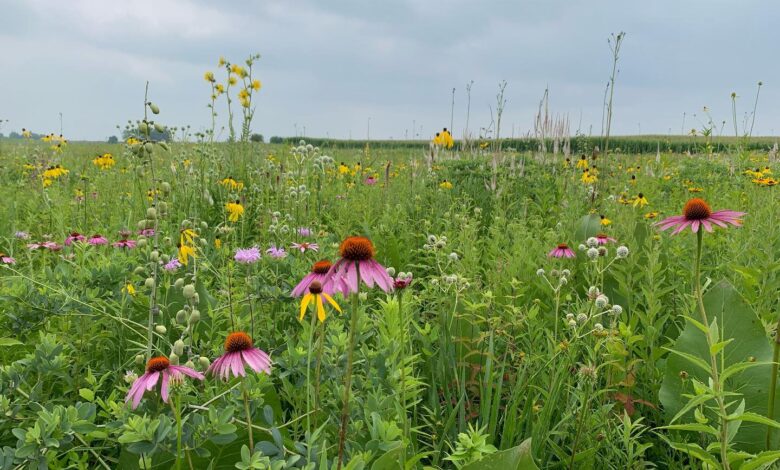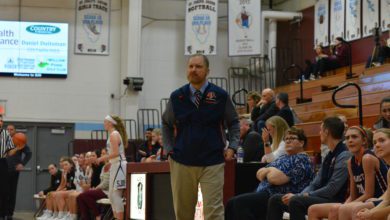Celebrating 75 Years of Lake of the Woods

A lot has changed since 1948.
Phones weren’t available in every home. Televisions were housed in a large wooden cabinet. Many families only had one car available for work, errands, and recreation.
In the 75 years that the Lake of the Woods Forest Preserve has been open to the public, a lot has changed there, too. What began as a small, rural park where residents could picnic, spend time on the water and walk has become a 900-acre regional destination.
With amenities and opportunities that not only give access to natural areas in Mahomet, Ill., the Lake of the Woods Forest Preserve is also home to a number of educational programs and recreational experiences.
The Lake
While taking a dive in the preserve’s lake is no longer an option, access to the 1.8-mile shoreline includes fishing and boating access. In 2020, the Champaign County Forest Preserve installed an ADA-accessible boat dock, providing access to all visitors to get into paddle boats and kayaks to enjoy the lake.
On weekends and holidays during the summer months, pedal boats or kayaks are available from 12-7pm for $8 per 30-minute trip.
The Forest Preserve offers so much more than water access, though. Since the mid-1950s, the Champaign County Forest Preserve has worked to offer more amenities to the 900-acre property.
Over the next two decades, four of the park’s main attractions were established. The boathouse was built beside the park’s main lake in 1960, followed by the Mabery Gelvin Botanical Gardens and the covered bridge.
Covered Bridge
Designed in the 1960’s by German Gurfinkel, a professor in the Department of Civil Engineering at the University of Illinois at Urbana-Champaign, the covered bridge was commissioned by the President of the Forest Preserve at the time, H.I. Gelvin to connect the two sides of Lake of the Woods Forest Preserve.
Mabery Gelvin Botanical Garden
In 1974, Gelvin dedicated a small garden outside the museum to his late wife, Mabery. The garden, which features a waterfall, a picturesque red bridge over a coy pond, and hundreds of plant species has grown to 8 acres today. Recently, the Champaign County Forest Preserve has hosted annual educational events alongside “Night Lights in the Garden” during the holidays there.
Museum of the Grand Prairie
Those educational opportunities usually stem from happenings at the Museum of the Grand Prairie. Since 1970, the Champaign County Forest Preserve’s museum has focused on preserving the history of the East Central Illinois area through permanent and annual exhibits. Currently, the Museum is looking back on the 75 years of the Champaign County Forest Preserve by bringing all six of the public body’s properties to life through historical dates and stories.
Permanent exhibits at the museum include “The Grand Prairie Story,” “Blacksmithing on the Prairie,” “Champaign County’s Lincoln,” “Discovering Home,” and “Vanishing Acts: Trees Under Threat.” In each exhibit, visitors learn about how the people and conditions shaped what makes the Champaign County area what it is today.
Today those lessons sometimes come to life in dynamic experiences, whether virtual or in person. The Museum of the Grand Prairie staff brings nature and history to life in their ongoing lecture series held in the educational wing of the building. During COVID-19 mitigations, staff worked hard to integrate technology into programming. Those practices have continued even as visitors have come back to the museum.
One Room Schoolhouse
The Lake of the Woods is also full of screen-free experiences, including the one-room schoolhouse. Originally serving as Hensley Town Hall in Hensley Township, the building transformed to become a one-room schoolhouse when it was moved to the Lake of the Woods property. This historic structure offers countless school children the opportunity to step back in time and immerse themselves in authentic 19th-century school lessons.
From the Museum of the Grand Prairie, access to a trail system that is envied by other Central Illinois communities is convenient. With more than 10 miles of trails, both paved and natural, winding through prairie, forest, alongside the Sangamon River, and around the Lake of the Woods Golf Course, anyone can find an accessible way to connect with nature on foot.
Buffalo Trace
The Champaign County Forest Preserve provides free and user-friendly parking at the heads of the Buffalo Trace Trail. The path, full of wildflowers in the summer months and the spectacle associated with fall leaves, pays tribute to the routes buffalo used as they migrated through the prairie. The Buffalo Trace Prairie also protects the prairies that once were the defining feature of the region.
Upon the arrival of the earliest settlers in Illinois, a staggering 22 million acres, which accounted for over 60% of the state’s land, was covered by sprawling prairies. However, as time progressed, significant changes took place, and today, a minuscule fraction of that original prairie remains. Presently, less than 0.01% of the original prairie endures, amounting to just over 2,000 acres.
With a mission to protect and preserve natural resources, the Champaign County Forest Preserve has put practices, such as controlled burns, in place in order to diminish the presence of invasive woody species and to foster the growth of wildflowers within prairie grass-dominated areas. Alongside ecological management, controlled burns enhance biodiversity and recycle nutrients within the prairie ecosystem.
Maintaining this natural environment of prairie grass aligns with the Preserve’s commitment to carbon emission reduction. While visitors may enjoy the tall grasses and colorful flowers that draw bugs and birds, prairie grass is an important component to carbon control and mitigation.
Prairie grasses have extensive root systems that can reach several feet into the soil. These deep and dense root systems facilitate the storage of carbon in the ground, a process known as carbon sequestration. As the grasses grow, they absorb atmospheric carbon dioxide (CO2) through photosynthesis, converting it into organic matter and storing the carbon in their roots, stems, and surrounding soil.
This process helps to reduce the concentration of CO2 in the atmosphere, mitigating the greenhouse effect and climate change. Once carbon is sequestered in the deep roots and soil, it can remain stored for decades to centuries, making prairies effective long-term carbon sinks. As prairies are relatively stable ecosystems, they offer a reliable means of carbon storage compared to annual crops or forests, which can be subject to more frequent disturbances.
Prairie grasses also contribute to the accumulation of soil organic matter, which is rich in carbon. The decomposition of plant materials, such as leaves, stems, and roots, adds organic carbon to the soil, enhancing its fertility and carbon storage capacity. This organic matter not only acts as a carbon sink but also improves soil structure, water retention, and nutrient cycling.
The Champaign County Forest Preserve has also taken on invasive plant removal measures by working with volunteers to remove plants like autumn olive or garlic mustard.
Over the years, the Champaign County Forest Preserve has expanded its paved trails through the Lake of the Woods Preserve, giving visitors access to the many amenities the park offers. From the path, children can play on the Lake of the Woods playground, families can eat at one of the park’s picnic shelters or climb the Hi-Tower.
Hi-Tower
As one of Lake of the Woods’ most iconic features, the Hi-Tower bell carillon, which is programmed to play music throughout the day, is a six-story window to the tree-line view of the Mahomet area. Climbers use the tower for training while fall enthusiasts climb the stairs for a birds-eye view of the autumn colors.
The Hi-Tower was built four decades ago, named for the founder of the Forest Preserve District, the late H.I. Gelvin. The tower also overlooks the Lake of the Woods Golf Course.
Lake of the Woods Golf Course
Opened in 1951, the course underwent a renovation in 1980. With an 18-hole, a 9-hole Par 3 Course, and a Foot Golf course, Lake of the Woods offers challenging play for golfers at every skill level.
Golfers will discover revitalized fairways, sand bunkers, ponds, and teeing grounds, complemented by newly paved cart paths and a redesigned entrance. Notably, the course proudly upholds its Certified Audubon Sanctuary status, a prestigious environmental distinction achieved by only two courses in the region. This esteemed recognition underscores the course’s commitment to eco-friendly practices and the preservation of natural habitats.


